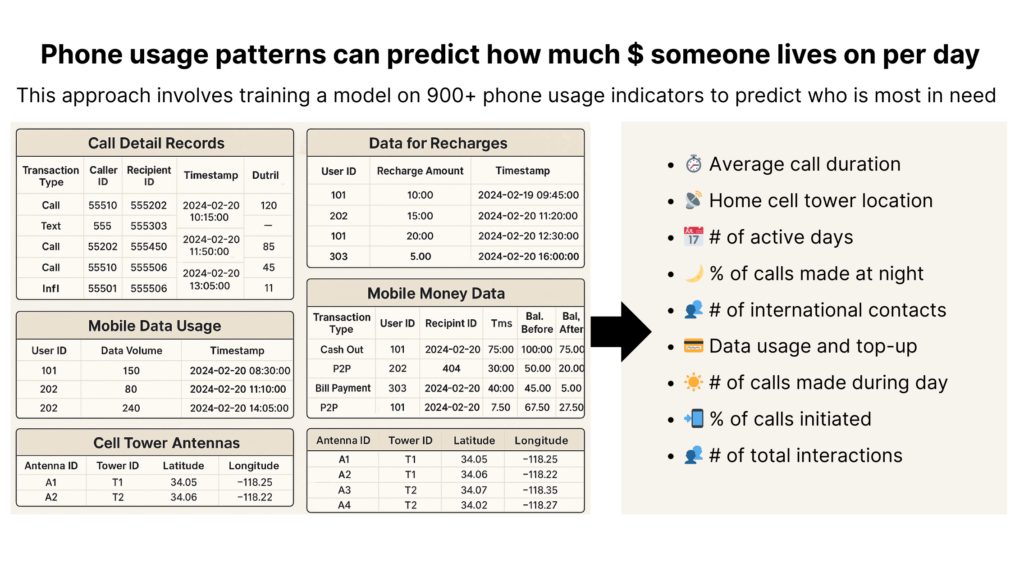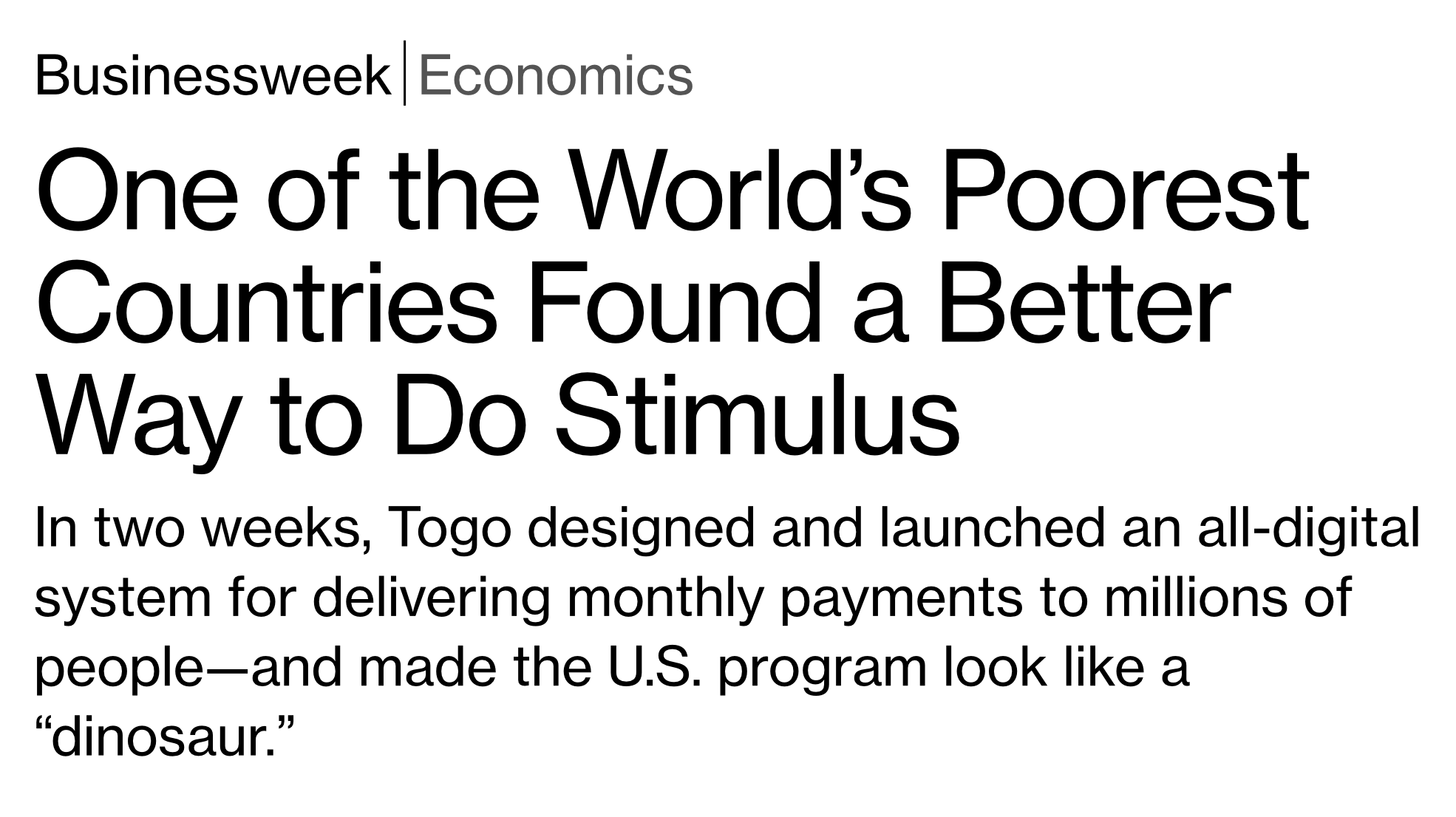Summary
- 📱 GiveDirectly has evaluated how mobile phone usage patterns and AI/ML methods can help governments and aid groups quickly identify and send mobile money to people in need across 4 countries since 2021 — Togo, DRC, Malawi, and Bangladesh.
- ⚡ This phone-based approach, which we call ‘MobileAid,’ often outperforms traditional methods at lower cost and faster speed, but requires strong telecom partnerships and trust with communities.
- 🤝 Our goal now is to scale MobileAid systems in partnership with telecoms and governments, making it easier to reach people in need during floods, droughts, and other crises.
Natural disasters, conflict, pandemics, and other crises are hitting more frequently and affecting more people. Unconditional cash transfers — delivered quickly before or after a shock — help families withstand these shocks. But to deliver cash quickly, governments and aid organizations need to solve a basic problem: How do you find the people most in need fast?
Quickly identifying people in need after a crisis is very challenging
Climate and economic shocks are already reversing progress on poverty and health. In Malawi, for every three people who escaped poverty between 2010 and 2019, four fell back due to climate shocks. Cash can help. During COVID-19, 1 in 6 people worldwide received a cash transfer — and research shows those who got money were less likely to lose income or face food insecurity.
But most low and middle-income countries lack accurate, up-to-date information on household income. Many governments rely on national social registries created years ago, which can miss families who have just lost work or been displaced.
GiveDirectly has been testing if mobile phone usage can quickly and accurately predict need
In 2021, GiveDirectly tested a new innovation: setting up technology so that people could self-enroll for emergency cash assistance via their phones (through a text message survey or our call center), get verified, and receive mobile money in minutes. This approach — called ‘MobileAid’ — is based on extensive research showing that anonymized phone usage patterns analyzed with machine learning can tell us where someone is located and if he/she is likely poor or in need:

🇹🇬 We first piloted this approach with the Government of Togo during COVID (click to read more)
This work began during COVID, when we partnered with CEGA and IPA to help the Government of Togo launch the world’s first aid program powered by phone metadata and digital payments—what we now call ‘MobileAid.’ Researchers first surveyed households using a proxy means test (20–30 questions on demographics, spending, and assets), then linked those survey results to phone metadata and trained a machine learning model to predict spending levels based on phone usage patterns.
The algorithm was then used to screen hundreds of thousands of people nationwide who applied for Togo’s emergency cash program. Within weeks, the government delivered digital payments to over 140,000 people. A peer-reviewed study in Nature later found this approach was 4–21% more accurate than the other targeting methods available at the time.

Since then, we’ve open-sourced the machine learning methodology and launched five more studies in Bangladesh, Malawi, Kenya, and DRC — three completed and two still underway — to understand where and when MobileAid works best. Here are five lessons so far:
1️⃣ Phone metadata ‘MobileAid’ is more accurate than most other targeting methods — except in-person surveys
📊 Across studies in Togo, Malawi, and Bangladesh, phone metadata outperformed most common ways of identifying people in need — such as community-based targeting (where local leaders nominate recipients) or simple proxies like location or occupation. The main exception was in-person proxy means tests (PMT), which are 20–30 question surveys on demographics, spending, and assets used to predict how much a family lives on per day.
Researchers tested each method against detailed in-person surveys, which revealed who was truly most in need and how many people each method correctly included — or wrongly left out. By this measure, phone metadata was less accurate than PMT but more accurate than other rapid methods typically used in emergencies.
| Method | Accuracy (AUC) | Speed | Cost |
|---|---|---|---|
| 📱Phone metadata (MobileAid) | Medium (0.61-0.72) | Fast (once built) | Low (at scale) |
| 📝 Proxy-means tests (PMT) | High (0.78-0.85) | Slow | High |
| 🌍 Location only | Low (0.55-0.66) | Fast | Low |
| 🛖 Community-based targeting | Low (0.58) | Slow | High |
📍 What’s next: We recommend using phone metadata when more detailed information (like recent PMT data) isn’t available — especially in fast-moving or large-scale crises. In Malawi, for example, we’re working with the government to update gaps in its urban social registry using phone metadata when it is prohibitively costly or time-consuming to conduct PMTs, so the government can more quickly screen and deliver assistance to over a hundred thousand households during crises.
2️⃣ Combining MobileAid and in-person surveys is important for reaching everyone, and can still cut costs in half
MobileAid is often more expensive to set up than the tools required for in-person surveys, but once built, it is much cheaper per each additional recipient enrolled.
🇧🇩 In Bangladesh, research showed that MobileAid was the most cost-effective option (resulting in the most amount of money reaching the neediest) for larger-scale programs that need to screen many households on a tight budget (e.g. government programs spending less than $10–50 to screen each household). But as the chart above shows, in-person surveying is more accurate.
🇲🇼 So in Malawi, we ran a hybrid program: we identified and enrolled 35% of recipients via phone metadata and the other 65% in person. This combined approach still cut the cost of identifying and enrolling each additional person in half, compared to a fully in-person operation.
📍 What’s next: We’re combining phone metadata with in-person surveys to reduce costs while ensuring no one is left out. In Kenya, we’re enrolling households — digitally and in-person — in flood- and drought-prone areas, so we can send cash when early warning systems predict extreme weather.
3️⃣ Once built, MobileAid can identify people in seconds, but systems currently take 6–18 months to set up
🏗️ Setting up MobileAid systems can require regulatory approval, data-sharing agreements with telecoms or governments, and integration with mobile communications, KYC and fintech companies to remotely enroll, verify, and pay people. It’s a complex process — systems can take 6–18 months to launch, compared to 4–6 months for our traditional in-person cash programs. Over the last four years, we’ve partnered with 11 telecoms and other data providers (such as social registries) to test these systems across six countries.

⚡ While upfront costs and effort are high, once live, these systems can identify recipients days after they choose to enroll — or even seconds if automated via API. That’s the core advantage: they take time to build, but once built, they enable rapid, flexible response.
📍 What’s next: We’re shifting toward longer-term partnerships, supporting telecom and government partners to run the data analytics themselves rather than relying on our teams. We’re also expanding to new countries so these systems can help digital cash reach more people in need — quickly, and at scale.
4️⃣ Phone metadata is highly sensitive, but there are safe ways to handle it with the right systems and protocols
🔒 While each country has its own data privacy laws, we’ve learned a few practices are essential: conducting data protection impact assessments, setting up clear data-sharing protocols in formal agreements, minimizing the data exchanged between parties, pseudonymizing phone numbers (replacing them with secure keys), and ensuring people give informed consent to share their data.
Setting up privacy-protecting systems takes additional work but is feasible. In Bangladesh, we partnered with government agencies to store and process the phone metadata on in-country government servers. In DRC, the raw data is also processed directly on in-country telco servers.
📍 What’s next: We’re moving toward models where data processing happens inside telecom or government systems, rather than externally. In Kenya, for example, we’re working with Safaricom to process phone metadata in-house, while ensuring visibility into code and model performance.
5️⃣ Explaining how MobileAid works is hard, but stories and visuals make it easier
🖼️ Even after testing different ways of explaining phone-based targeting, we found it’s difficult to create an explanation that most people can easily grasp and that works at scale. But when we used a four-paragraph script with real-life scenarios and visuals, people were much more likely to explain the approach back in their own words.

📍 What’s next: We’re testing different ways to explain MobileAid at scale — via phone calls, videos, and text messages — in a randomized controlled trial. The goal is to ensure everyone can have better understanding and give truly informed consent when participating in these programs.
Now we’re testing more questions and applications
In addition those improvements above, we’re focused on three other big questions:
🏃♂️ How well can phone metadata identify people who are displaced?
We’re working with Flowminder in DRC to study how well mobile data can detect people displaced by major crises such as conflicts. Findings expected 2026–2027.
📉 Can phone metadata detect changes in poverty after a crisis?
So far, we’ve measured accuracy at a single point in time: did the method correctly measure someone’s daily spending before a shock. But crises change people’s financial stability quickly. We’re working with the Government of Malawi and researchers at U.C. Berkeley and U.C. San Diego to study whether phone metadata can flag people whose poverty deepens after a shock. Findings expected in 2026.
🗣️ How do recipients prefer to be identified?
Some people prefer to be identified remotely; others want face-to-face interaction. We’re running more qualitative research to understand preferences and eventually build them into program design.
MobileAid is ready to scale and improve humanitarian responses worldwide
With a total of four research studies complete and two ongoing, we’re now focused on helping governments and telecoms adopt MobileAid at a national scale.
While there are certainly limitations, mobile phone ownership is growing rapidly. In Kenya, 93.5% of households now own at least one phone); in Bangladesh, 97%. Rates are lower in rural and lower-income areas, but rising. That makes mobile phones one of the most scalable tools available to reach people in poverty, fast. The next step is expanding the systems and partnerships to use them — when the next flood, fire, or pandemic hits.
🚀 Join our team: we’re hiring a Senior Product Manager, Mobile Operator Data to expand this work.